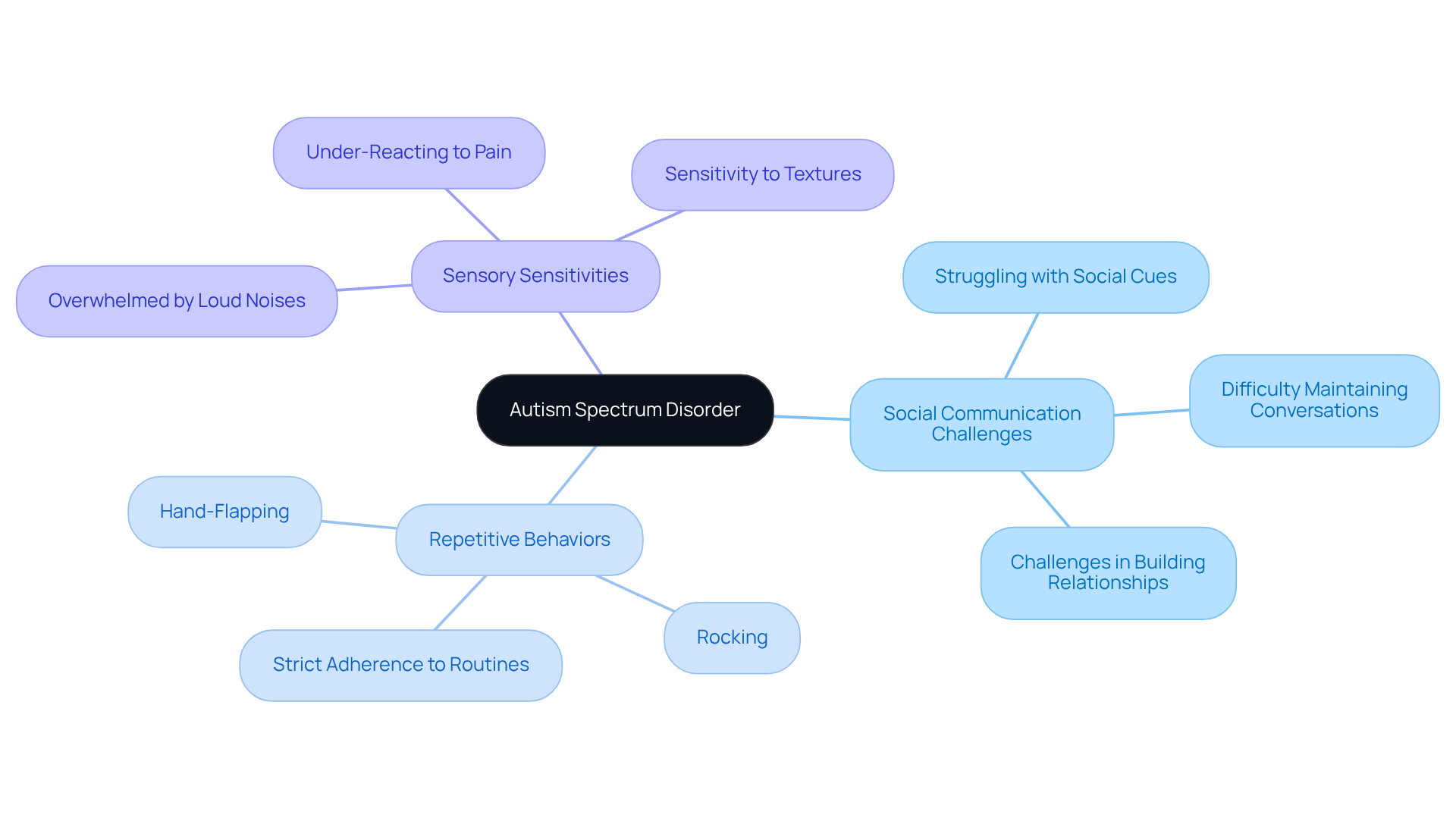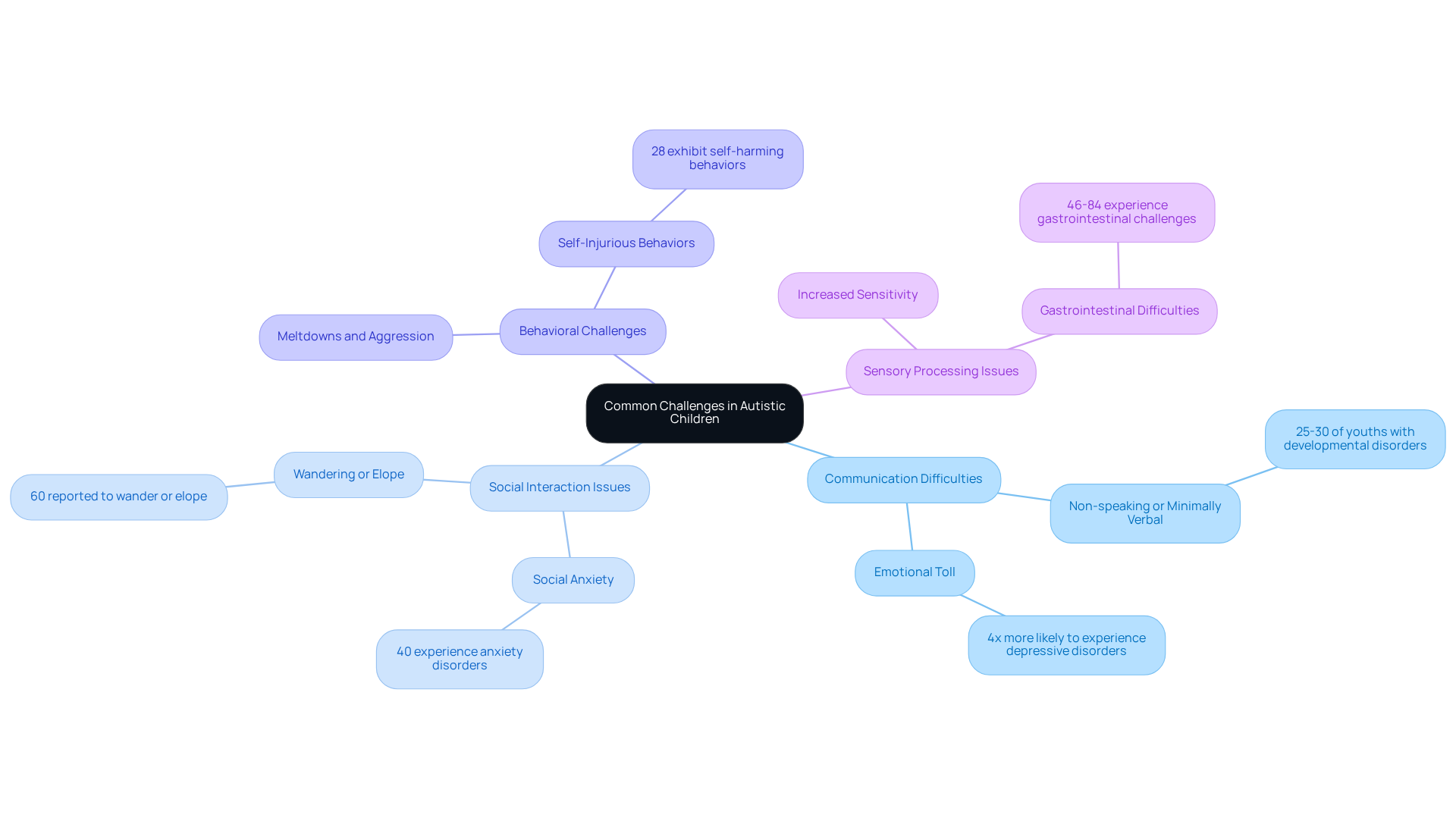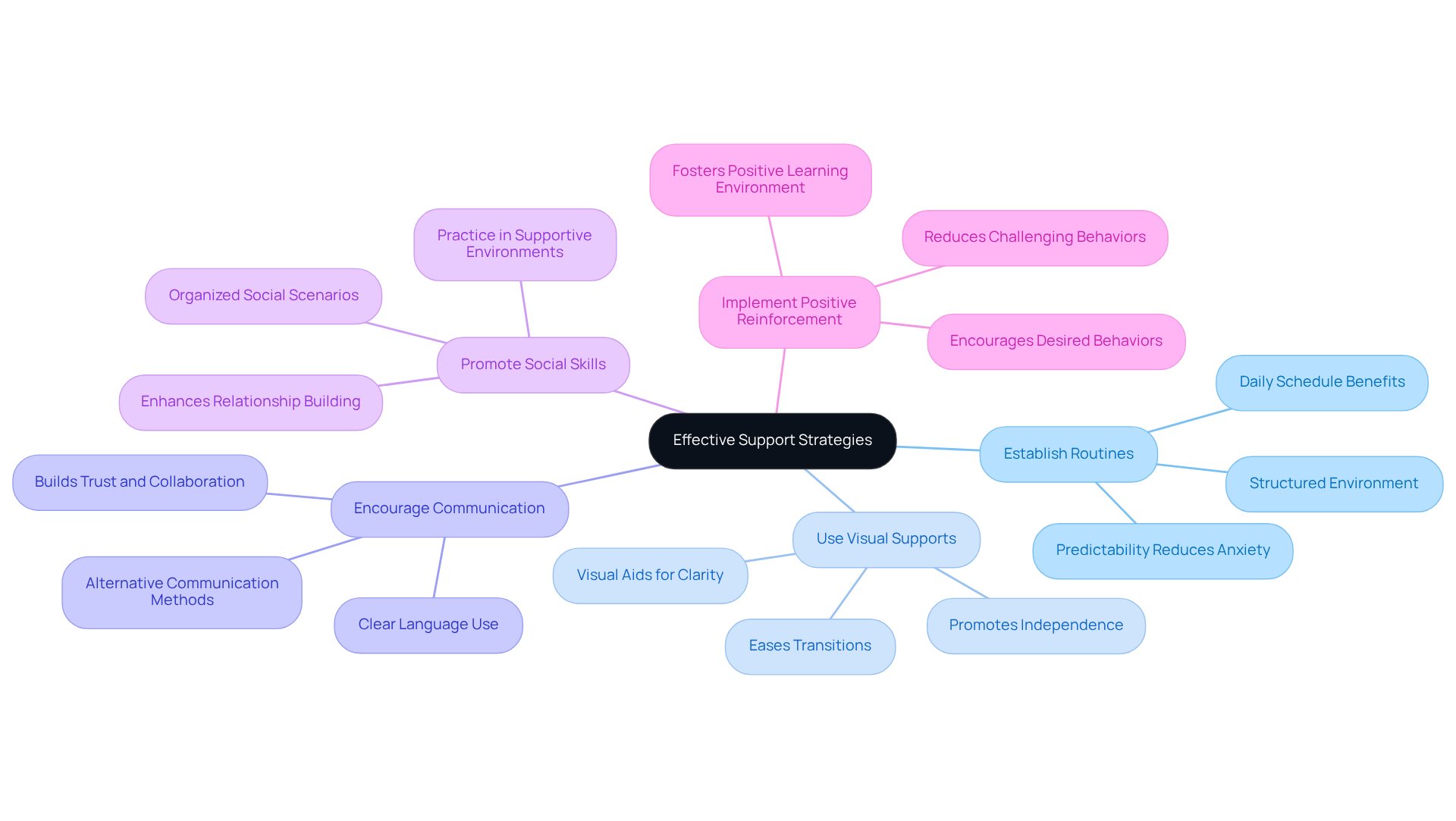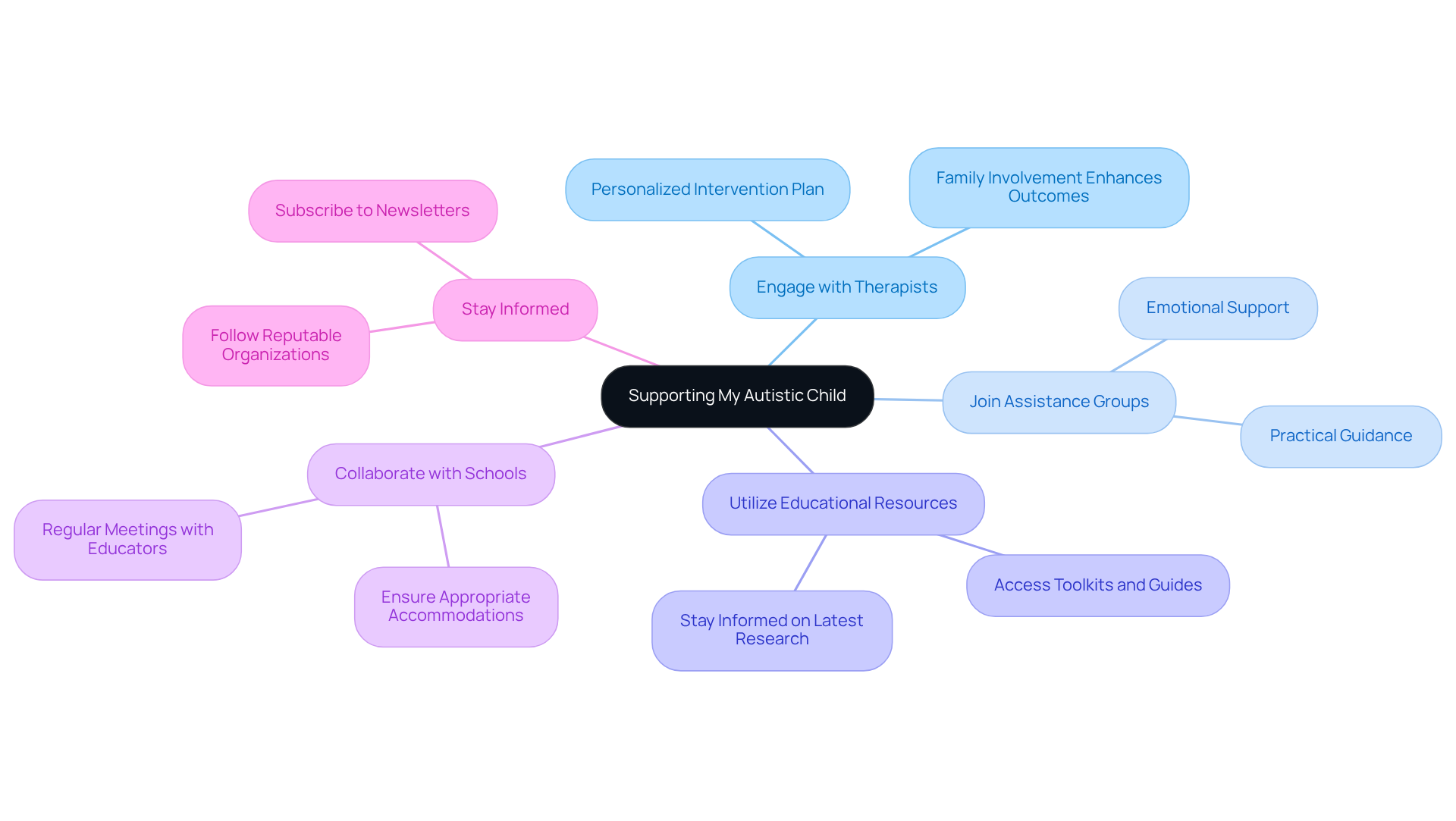Overview
Supporting the development of autistic children is a journey that requires understanding and compassion. There are four essential steps that can make a significant difference:
- Recognizing their unique challenges
- Implementing effective support strategies
- Collaborating with professionals
- Accessing valuable resources
Research shows that tailored interventions, structured routines, and community support can greatly enhance the well-being and growth of children with Autism Spectrum Disorder (ASD).
As parents, it’s vital to acknowledge the distinct experiences your child faces. Each step not only addresses their specific needs but also creates a nurturing environment where they can thrive. Imagine the positive impact of structured routines that provide stability and predictability, making daily life easier for both you and your child.
Collaboration with professionals is another crucial aspect. By working together, you can develop strategies that are tailored to your child’s strengths and challenges. This partnership can empower you with the knowledge and tools necessary to support your child effectively.
Finally, accessing resources—be it community programs, support groups, or educational materials—can provide you with the additional help you need. Remember, you are not alone in this journey. Reach out, share your experiences, and connect with others who understand. Together, we can foster an environment where every child with ASD can flourish.
Introduction
Understanding Autism Spectrum Disorder (ASD) is vital for creating a nurturing environment for children affected by this complex condition. With approximately 1 in 36 young people diagnosed in the U.S., parents and caregivers often grapple with recognizing and addressing their children's unique needs. This article delves into effective strategies designed to support the development of autistic children, offering practical steps that empower families to craft tailored approaches. How can parents navigate the intricacies of autism to ensure their child not only copes but thrives in a world that can often feel overwhelming?
Understand Autism Spectrum Disorder
Autism Spectrum Disorder (ASD) is a multifaceted neurodevelopmental condition that presents unique challenges in social interaction, communication, and behavior. Each individual experiences the spectrum differently; some young people may face significant difficulties, while others exhibit milder symptoms. Understanding these variations is crucial for parents and caregivers, as it allows them to recognize and appreciate their child's unique characteristics.
Key characteristics of ASD include:
- Social Communication Challenges: Children with ASD often find it hard to interpret social cues, maintain conversations, and build relationships. For example, they might struggle to understand non-verbal signals like facial expressions or tone of voice, which can make connecting with peers a challenge.
- Repetitive Behaviors: Many young individuals engage in repetitive movements or speech patterns and may adhere to strict routines. This can manifest as hand-flapping, rocking, or a strong preference for specific rituals, providing them with a sense of comfort and predictability.
- Sensory Sensitivities: Sensory processing issues are common, leading to over- or under-reactions to sensory stimuli such as sounds, lights, or textures. For instance, a young person might feel overwhelmed by loud noises or may not respond to pain as expected.
By familiarizing themselves with these traits, parents can better support their child's development and find help for autistic child while navigating the complexities associated with ASD. Recent statistics indicate that approximately 1 in 36 young people in the U.S. are affected by this condition, underscoring the importance of awareness and understanding in fostering supportive environments for individuals on the spectrum.

Identify Common Challenges in Autistic Children
Understanding the challenges faced by autistic children is crucial for parents who wish to provide help for autistic child development and well-being. These challenges encompass a range of difficulties that can significantly impact their daily lives:
-
Communication Difficulties: Many children with autism spectrum disorder (ASD) encounter significant barriers in both verbal and non-verbal communication. This struggle can hinder their ability to express needs or comprehend others, leading to frustration and misunderstandings. It’s important to note that around 25-30% of youths with developmental disorders are non-speaking or minimally verbal, which exacerbates these challenges. Moreover, individuals on the spectrum are four times more likely to experience depressive disorders compared to the general population, highlighting the emotional toll these communication difficulties can take.
-
Social Interaction Issues: Engaging with peers can be particularly daunting for autistic individuals, often resulting in feelings of isolation. Research indicates that social anxiety is common, with approximately 40% of individuals on the spectrum experiencing anxiety disorders, further complicating social interactions. Additionally, about 60% of youngsters with developmental disorders are reported to wander or elope, presenting significant safety hazards and complicating their social experiences.
-
Behavioral Challenges: Autistic individuals may exhibit behavioral issues such as meltdowns, aggression, or self-injurious behaviors, frequently triggered by overwhelming situations or changes in routine. Notably, 28% of youngsters with developmental disorders display self-harming behaviors, which can be distressing for both the individual and their caregivers, necessitating effective management strategies.
-
Sensory Processing Issues: Many young individuals on the spectrum exhibit increased sensitivity to sensory stimuli, leading to discomfort in overly loud, bright, or chaotic environments. This sensory overload can significantly affect their ability to participate in everyday activities. Furthermore, gastrointestinal difficulties influence 46-84% of individuals with autism, which can coincide with sensory processing concerns and impact overall well-being.
Recognizing these challenges is essential for guardians, as it empowers them to create tailored approaches that provide help for autistic child development and well-being. By understanding the unique difficulties their children face, parents can more effectively advocate for the necessary support and resources. If you have experiences to share or need guidance, consider reaching out to community resources or joining support groups where you can connect with others who understand your journey.

Implement Effective Support Strategies
To effectively support the development of your autistic child, consider implementing the following nurturing strategies:
- Establish Routines: Children with Autism Spectrum Disorder (ASD) often thrive in structured environments. By creating a daily schedule that includes consistent times for meals, activities, and bedtime, you can significantly reduce anxiety and enhance emotional stability. Predictable routines offer a sense of security, helping your child navigate their daily lives more comfortably. As Dr. O. Ivar Lovaas wisely stated, 'If they can’t learn the way we teach, we teach the way they learn,' underscoring the importance of customized strategies in supporting autistic individuals.
- Use Visual Supports: Visual aids such as charts, schedules, and social stories are invaluable tools in therapy for individuals on the spectrum. They assist your child in grasping expectations and managing daily activities more easily. Research indicates that visual schedules can promote independence by clarifying the sequence of activities, making transitions smoother and less stressful. Regular use of visual aids can greatly improve learning outcomes for children with autism.
- Encourage Communication: Clear and simple language is essential when communicating with your child. Encourage them to express themselves and consider alternative communication methods, such as picture exchange systems or speech-generating devices, if necessary. Effective communication strategies build trust and collaboration, which are crucial for your child's progress.
- Promote Social Skills: Involving your child in organized social scenarios, such as playdates or group activities, allows them to practice social interactions in a supportive environment. These experiences can enhance their social skills and help them build meaningful relationships.
- Implement Positive Reinforcement: Rewarding desired behaviors with praise or small rewards encourages the repetition of those behaviors. This approach can effectively reduce challenging behaviors over time, fostering a positive learning environment.
By applying these strategies, you can create a nurturing environment that provides help for autistic child growth and development, empowering them to thrive. Moreover, integrating flexibility into routines can assist them in adapting to unforeseen changes, further enhancing their emotional health.

Collaborate with Professionals and Access Resources
To effectively support your autistic child, consider these collaborative steps to access valuable resources:
- Engage with Therapists: Work closely with ABA therapists, speech therapists, and occupational therapists to develop a personalized intervention plan that caters to your child's unique needs. Research shows that family involvement in therapy enhances outcomes, making this collaboration vital. As ASD Media notes, "The involvement of families in interventions for individuals with autism is crucial."
- Join Assistance Groups: Connect with local or online support groups that offer help for autistic child guardians. These groups provide emotional support and practical guidance. Studies indicate that caregivers who participate in support networks experience reduced stress levels and improved coping strategies. Notably, 72.5% of mothers of autistic children reported depressive symptoms, underscoring the emotional challenges faced by caregivers.
- Utilize Educational Resources: Access resources that provide help for autistic child from reputable organizations offering toolkits, guides, and information on navigating services for individuals on the spectrum. Staying informed about the latest research and therapies empowers parents to make educated decisions. The CDC reported that in 2023, approximately 1 in 36 youngsters in the United States is diagnosed with autism, highlighting the need for effective support.
- Help for autistic child: It is important to collaborate with your child's school to ensure they receive appropriate accommodations and support in the classroom. Regular meetings with educators and special education personnel can help monitor progress and adjust strategies as needed, fostering a cooperative environment for your child's education.
- Stay Informed: Subscribe to newsletters and follow reputable autism organizations to find help for autistic child, as well as the latest research, therapies, and resources available for families. This ongoing education can significantly impact your child's development and well-being. As ASD Media emphasizes, "Early intervention equips youngsters with the tools and strategies they require to navigate their environment, communicate effectively, and develop essential life skills."
By fostering collaboration and utilizing available resources, parents can build a strong support system that enhances their child's development and well-being.

Conclusion
Understanding the complexities of Autism Spectrum Disorder (ASD) is essential for fostering an environment where autistic children can thrive. By recognizing the unique challenges they face—such as communication difficulties, social interaction issues, and sensory sensitivities—parents and caregivers can tailor their approaches to better support their child's development. This understanding forms the foundation for effective strategies that promote growth, well-being, and a sense of belonging.
The article outlines several key strategies for supporting autistic children, including:
- Establishing routines
- Utilizing visual aids
- Encouraging communication
- Promoting social skills
- Implementing positive reinforcement
Each of these methods plays a vital role in creating a nurturing environment that not only helps children adapt but also empowers them to navigate the world with greater confidence. Additionally, collaborating with professionals and accessing available resources can significantly enhance the support provided, ensuring that children receive the tailored interventions they need.
In conclusion, supporting an autistic child is a multifaceted journey that requires patience, understanding, and proactive engagement. By embracing the insights shared in this guide, parents and caregivers can cultivate a supportive atmosphere that fosters development and resilience. Taking steps to connect with professionals, engage in community support, and stay informed about the latest research can further enhance the impact of these strategies. Ultimately, the goal is to empower autistic children to reach their full potential, and every effort made in this direction contributes to a more inclusive and understanding society.
Frequently Asked Questions
What is Autism Spectrum Disorder (ASD)?
Autism Spectrum Disorder (ASD) is a multifaceted neurodevelopmental condition characterized by unique challenges in social interaction, communication, and behavior. Each individual experiences the spectrum differently, with some facing significant difficulties and others exhibiting milder symptoms.
What are the key characteristics of ASD?
Key characteristics of ASD include social communication challenges, repetitive behaviors, and sensory sensitivities. Children with ASD may struggle to interpret social cues, engage in repetitive movements or speech patterns, and have varied reactions to sensory stimuli.
How do children with ASD struggle with social communication?
Children with ASD often find it hard to interpret social cues, maintain conversations, and build relationships. They may have difficulty understanding non-verbal signals such as facial expressions or tone of voice, which can hinder their ability to connect with peers.
What are some examples of repetitive behaviors in individuals with ASD?
Repetitive behaviors may include movements such as hand-flapping or rocking, as well as a strong preference for specific routines or rituals, which provide comfort and predictability to the individual.
What are sensory sensitivities in the context of ASD?
Sensory sensitivities refer to issues with sensory processing that can lead to over- or under-reactions to sensory stimuli, such as sounds, lights, or textures. For example, a child with ASD may feel overwhelmed by loud noises or may not respond to pain in a typical manner.
Why is it important for parents and caregivers to understand ASD?
Understanding the characteristics of ASD allows parents and caregivers to recognize and appreciate their child's unique traits, enabling them to better support their child's development and navigate the complexities associated with the condition.
How prevalent is Autism Spectrum Disorder in the U.S.?
Recent statistics indicate that approximately 1 in 36 young people in the U.S. are affected by Autism Spectrum Disorder, highlighting the importance of awareness and understanding to foster supportive environments for individuals on the spectrum.




